Like Kubah National Park, the Santubong peninsula is another relatively intact forest remnant on the outskirts of Kuching, the capital city of the Malaysian state of Sarawak, in northwest Borneo. The peninsula encompasses habitats from the beach up to the mountain peak, which at less than 3,000 feet is not particularly impressive on paper, but which does shoot up rather dramatically from the surrounding lowlands. Alfred Russel Wallace hung out in Santubong when he was formulating his early thoughts on the origin of species.
I stayed for a few nights at Permai Rainforest Resort, which is as far north on Santubong as one can stay. My original plan was to use Permai as a home base while periodically meeting up with the legendary Hans Breuer, but unforeseen Breuer family obligations left me Hans-less. Fortunately for me, Permai is just three-quarters of a mile or so to the entrance to Santubong National Park, which features hiking trails through some excellent rainforest. And Permai has its own hiking trails as well. Permai also has a decent café, and a popular food court is just down the road. So I had everything I would need to herp by myself for a few days, on foot.
Did I mention treehouses? When I discovered that among Permai's lodging options were treehouses, I knew I (well, really Hans) had made the right choice. The stairs were significant, but the rainforest-and-ocean views were well worth the climb.
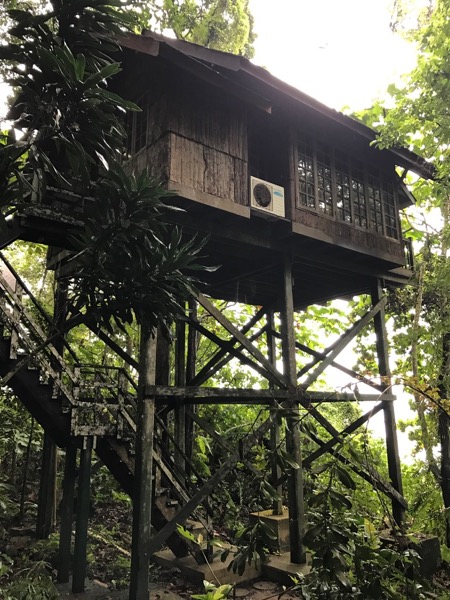
The trails in both Permai and Santubong NP were all very gorgeous and pretty hazardous. Not even considering the trail to Santubong peak, which I did not brave, all of the trails had very steep sections, and often crossed streams in less than optimal ways. Here are a few examples.
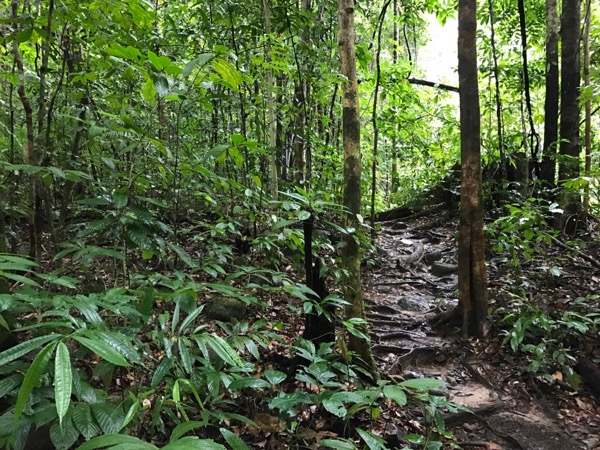
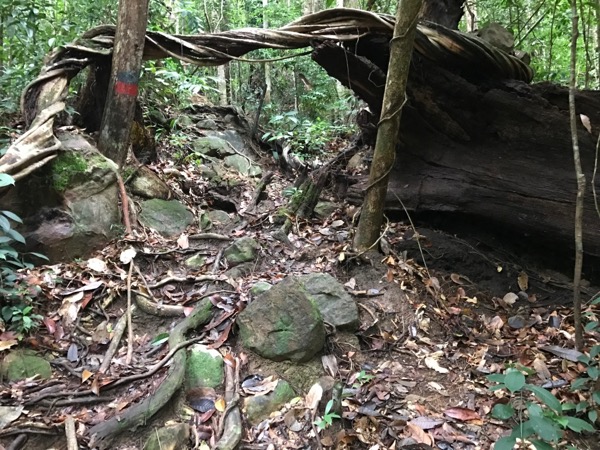
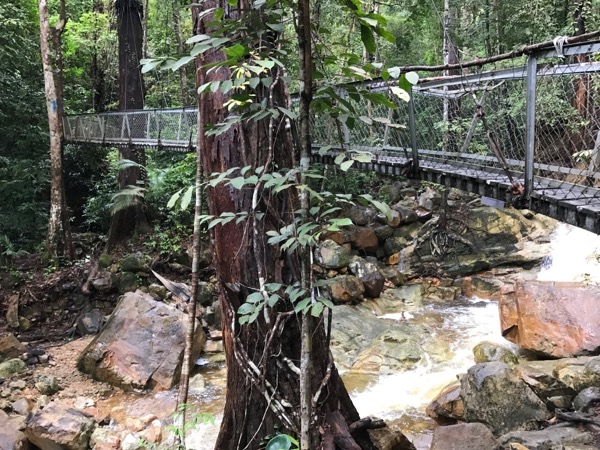
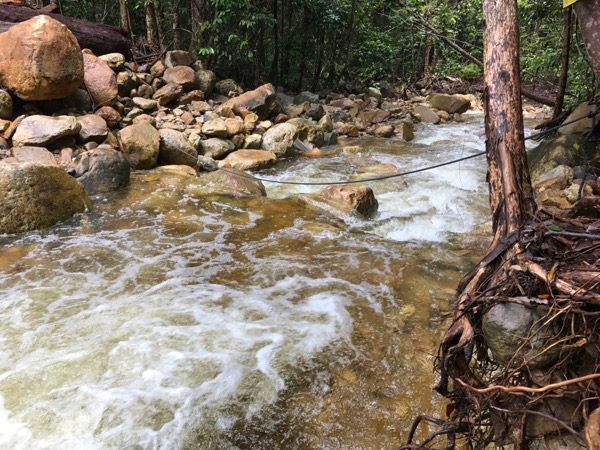
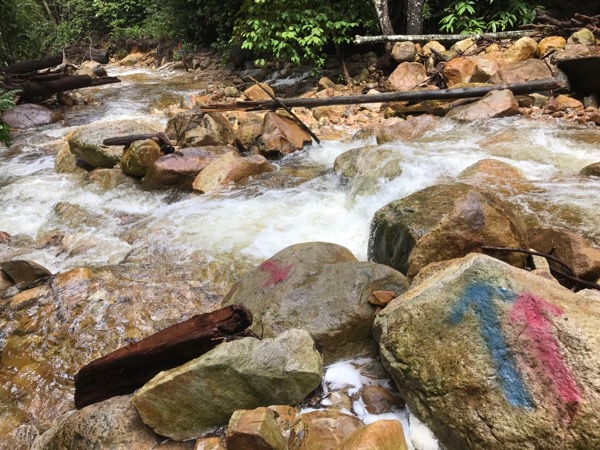
Nearly all of the wildlife activity was after dark. I'll start with a few of the more interesting invertebrates.
I had fun spotting phasmids of every shape and size, and then trying to identify them when I got home. With the help of some excellent books and a couple of generous phasmid experts, I ended up with at least partial IDs for most of them. Phasmids are so cool.
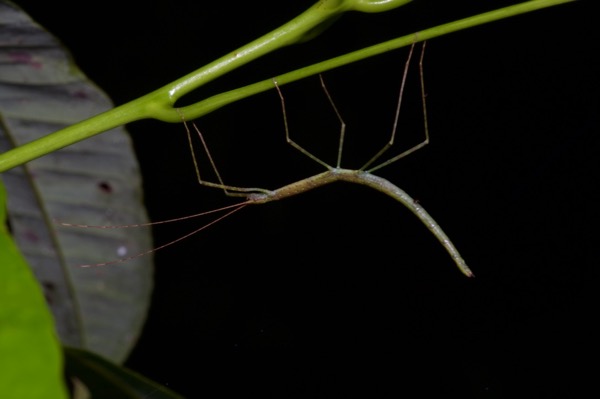
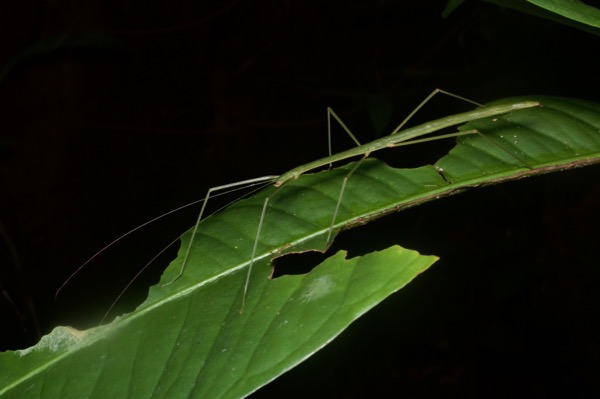
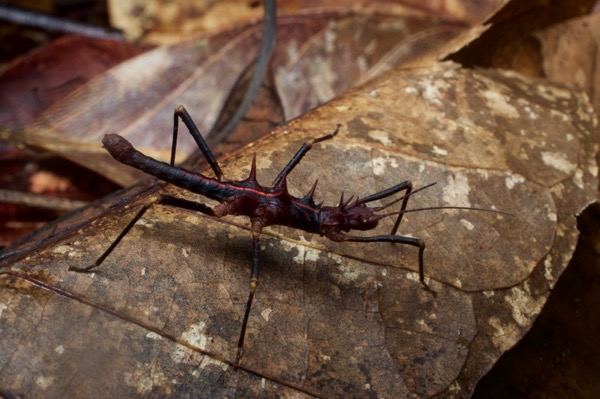
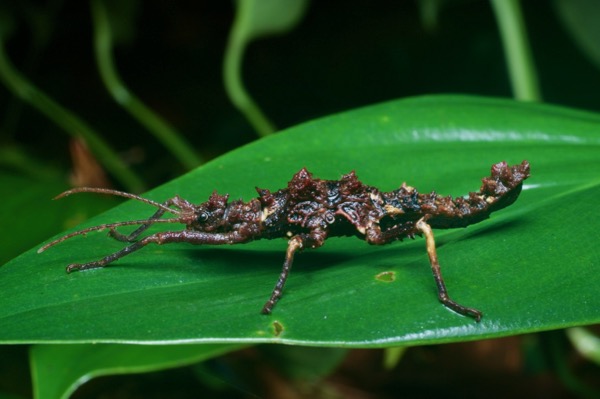
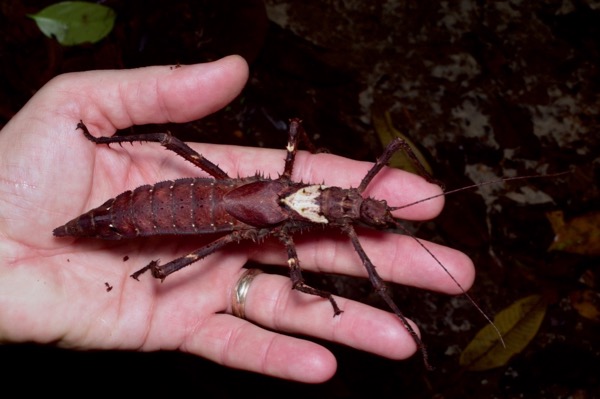
Very large ants were common in the forest. Often they were by themselves, but sometimes they were with a few of their fellow ants. This one might have been milking nectar from a little hopper, but I didn't catch that in action if so.
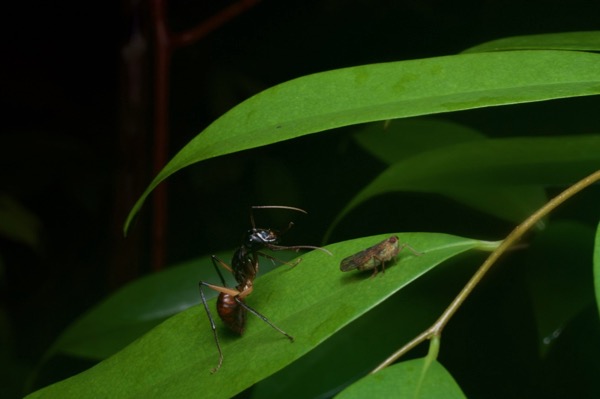
I wasn't quite sure what this little Tron-colored bug was when I first spotted it. Beetle? True bug? Looking at the photo later I realized it was a teeny katydid, probably a nymph. Kurt recognized it later as part of the katydid genus Scambophyllum.
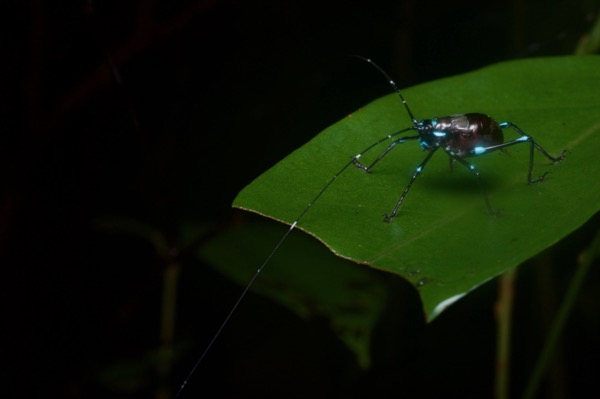
One of the Spiders From Mars, chomping a beetle or perhaps roach.
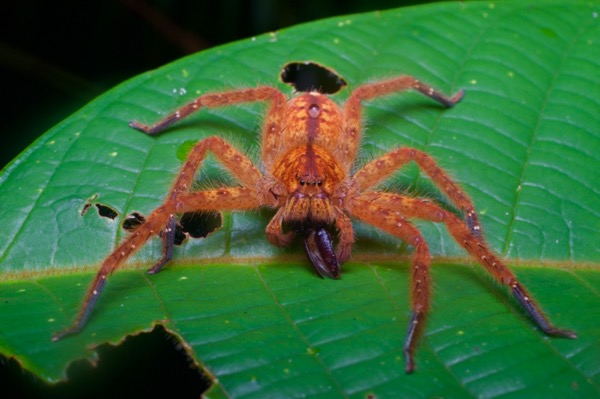
I think these guys are among the creepier Southeast Asian invertebrates. I saw several of them, most of which were scuttling away at the time. This one was just hanging out creepily.
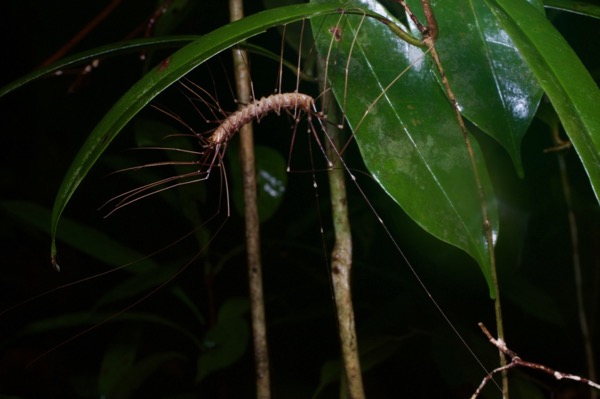
Don't crabs belong in the ocean or at least on the beach? A crab on a leaf in the rainforest just seems wrong.
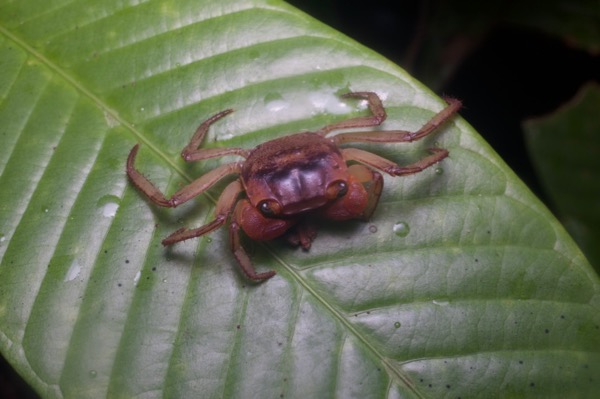
Since I have spent very little time in Asia, my reaction to macaques is still "Ooh, a monkey!". Everyone who has been here longer has soured on their thieving antics.
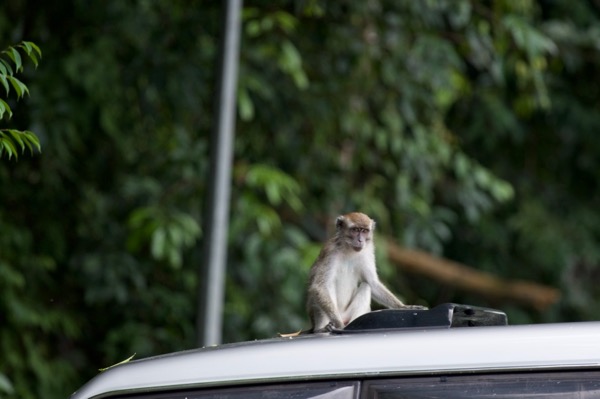
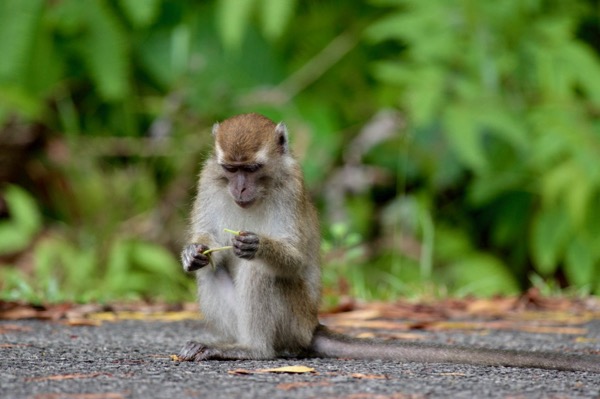
I saw considerably fewer frogs at Santubong than at Kubah, but I did see a few new species, including this long-leggedy toad.
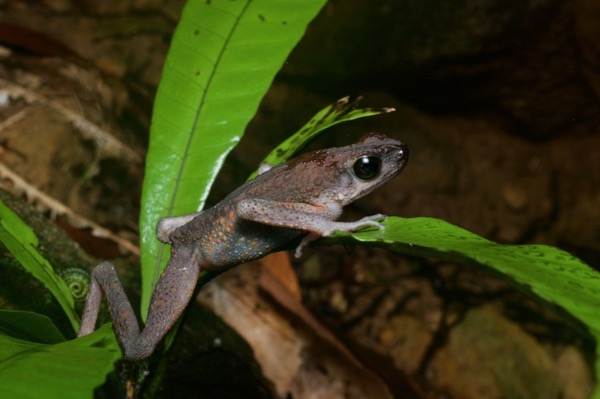
This teeny toad was also new to me.
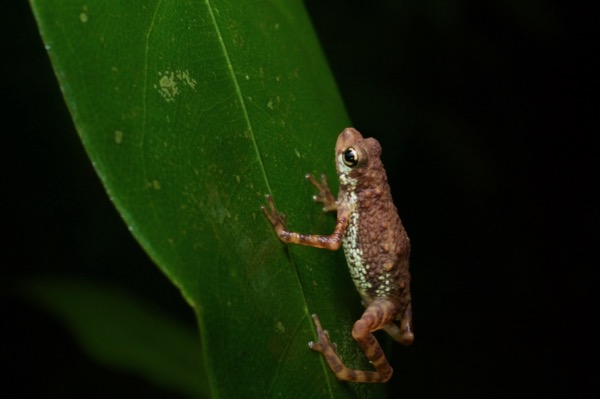
At a small pond just off the trail at Santubong National Park I found this fairly generic treefrog species that I had also seen at Kubah.
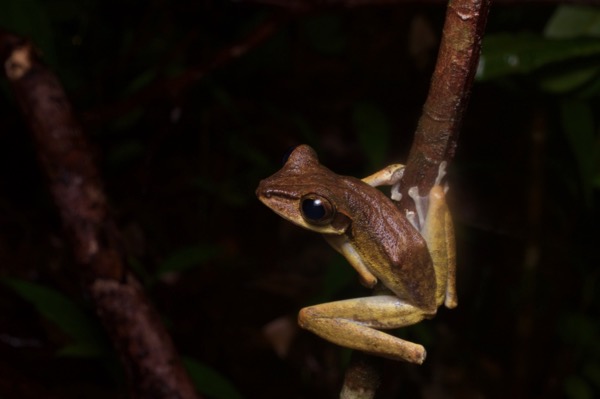
And at the same pond I also found this similar species, which was new to me. Since there were so many different species, I got in the habit of trying to photograph every individual frog that I could, to avoid letting cryptic diversity slip through my fingers.
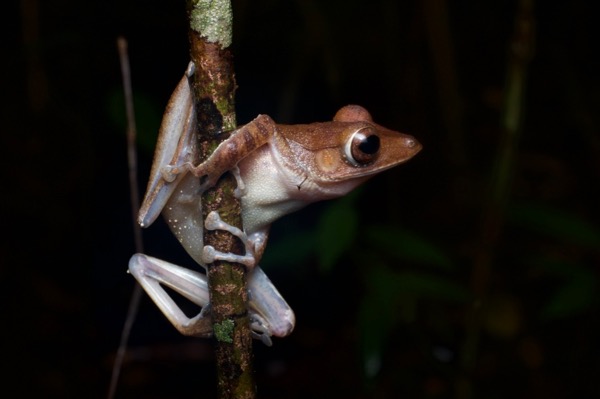
I assumed this one was Chalcorana raniceps, a species I had seen at Kubah. But it might be Chalcorana megalonesa, a very similar but larger species. I wasn't thinking that I would have to measure every frog I saw to help ID it later.
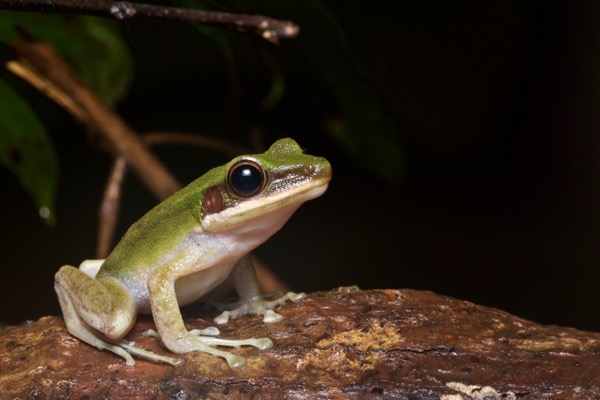
Wary big-eyed frogs occupied most of the numerous shallow streams in the area. For now, these are all lumped together in a single species complex, though some differences in color and texture are pretty obvious.
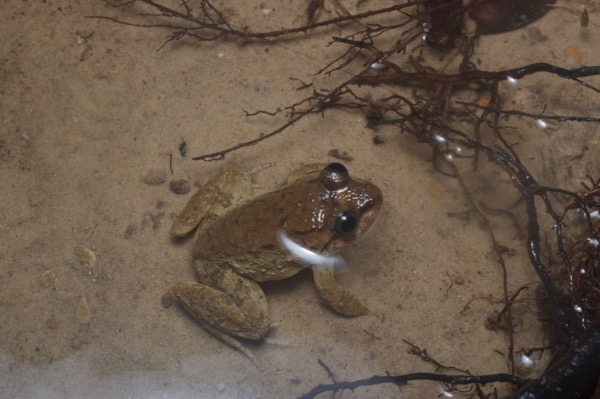
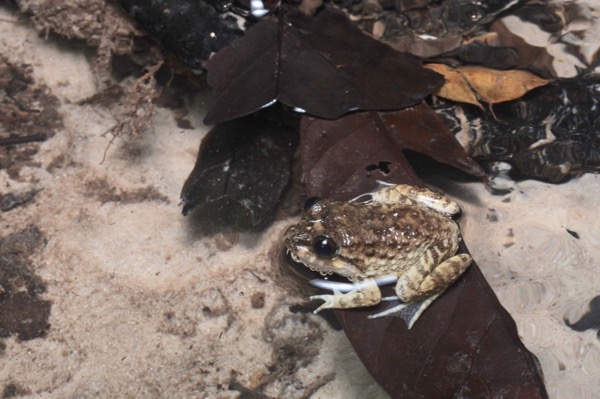
Occasional eye shine in the leaf litter would reveal one of the goofy-looking ambush predators known as Litter Frogs. Close to sea level I saw a few of these, a species I had also seen at Kubah.
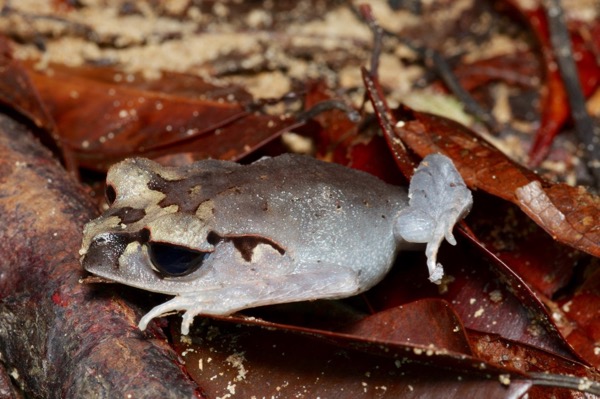
Near the high point of the trail at Permai I also found a couple of this closely related species, identifiable by the dark spots on the flanks and belly.
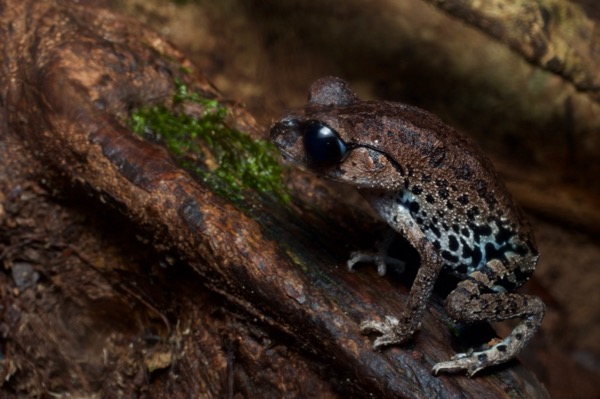
A few moments after checking in at Permai Rainforest Resort, I noticed this fat skink basking on a fallen palm stalk along the walkway. I was following someone to my room (excuse me, my treehouse), so I came back ten minutes later to immortalize the skink digitally.
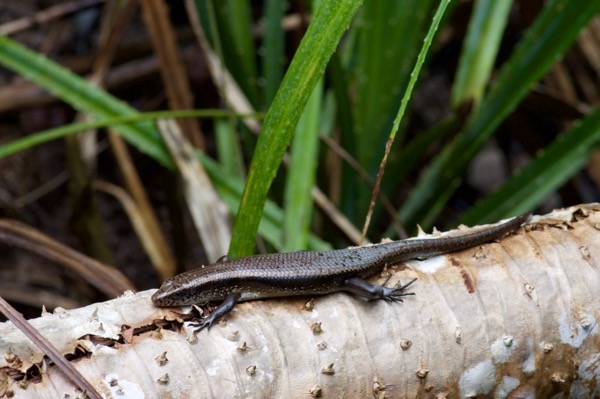
I saw only one other type of skink here, an interesting water-loving species. Unfortunately I only saw this one individual, who was creekside while I was crossing the creek on a bridge, and it was only visible for a few seconds. Still, this was better than at Kubah, where I had glimpsed two or three of these right at dusk as they disappeared into a trailside stream, leaving me with no photos at all.
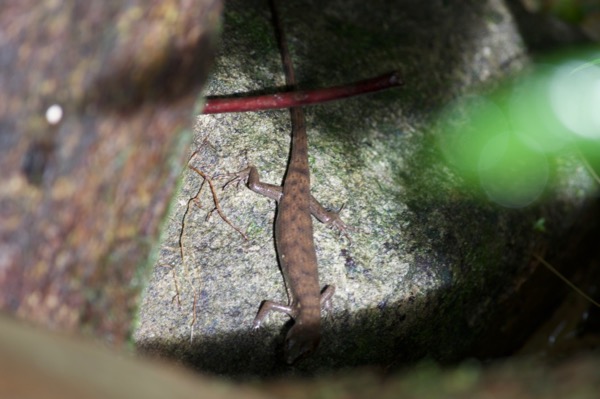
The gecko fauna I saw at Santubong was similar to that of Kubah, with more cosmopolitan house gecko species thrown into the mix. Those house geckos were probably also present at Kubah, but they were more obvious at Santubong on various buildings, walls, and developed areas in general.
For example, here's a quite generic house gecko on a planted tree near the Santubong food court.
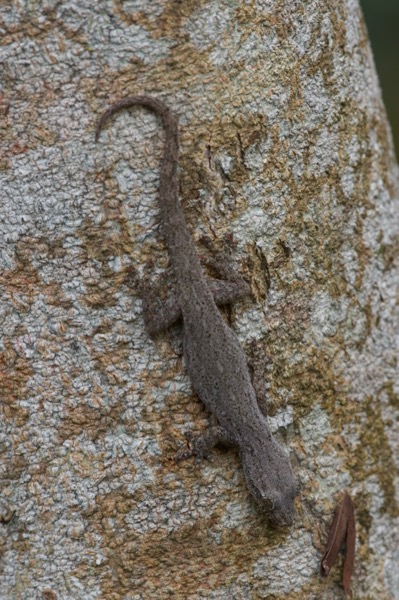
Damai Beach Resort is the fancier, more recreation-oriented sibling of Permai Rainforest Resort, and located right next door. The two establishments might be owned by the same people, I'm not sure. Damai Beach Resort has a big stone sign out front, which was always good for a dozen or more geckos at night (and usually at least a few during the day). I didn't spend too much time trying to photograph these annoyingly wary geckos, and the only decent photos I got were of an individual with a partly regenerated tail.
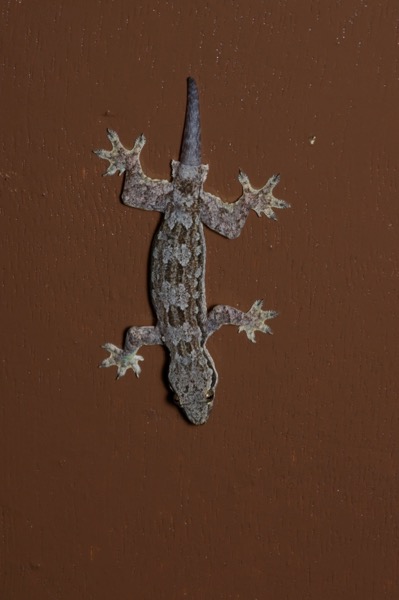
In the forest, it was easy to find Cnemaspis geckos clinging to large boulders and buttress roots. Most of them would dart away quickly, but if I approached carefully enough I would occasionally find one that would hold its position for a close-up.
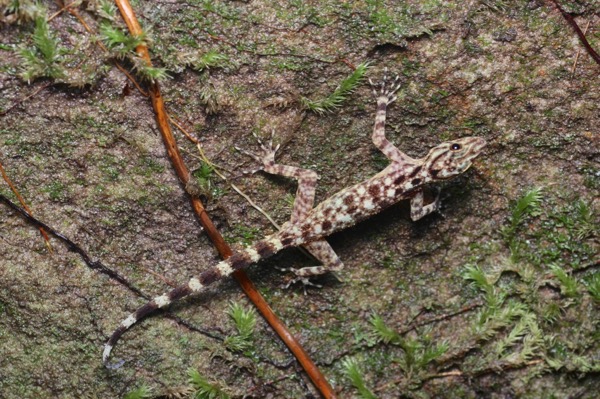
The next most common forest gecko was a medium-sized Cyrtodactylus species typically found in leafy vegetation or on twigs. It's extremely similar to the C. quadrivirgatus that I saw many times in Peninsula Malaysia, but my understanding (see, e.g., this paper on Bornean Cyrtodactylus) is that the ones in this part of Borneo are C. pubisulcus.
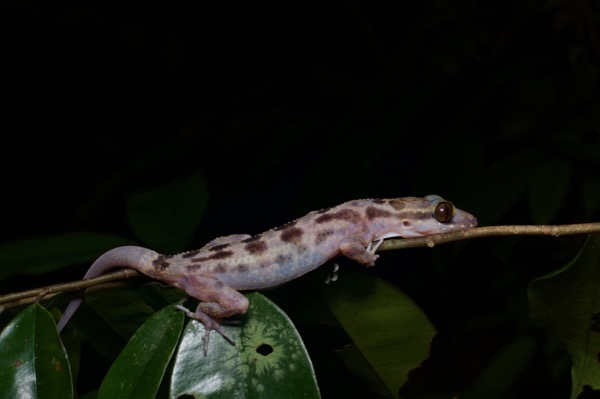
I also saw a number of the larger Cyrtodactylus that typically hang out on thicker branches, buttresses, or boulders. As far as I know, these haven't yet been split from their Peninsula Malaysia counterparts. But given the trend in lizard taxonomy in Southeast Asia, I will not be the least bit surprised in a year or three if the Borneo populations are elevated to their own species.
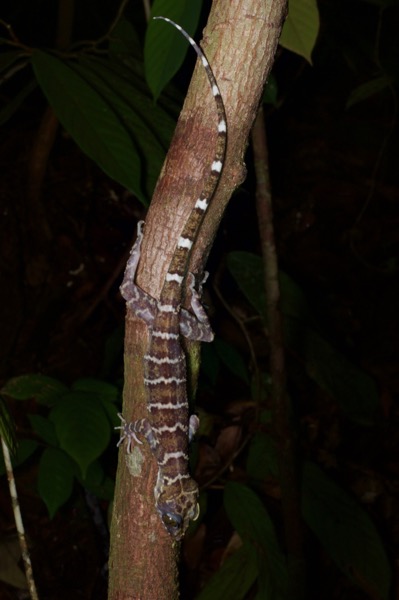
Santubong continued my trend of being terrible at finding agamids during the day. The only species I saw during their actual active hours was the very common but nonetheless eye-catching Bronchocela cristatella. I saw one at Santubong National Park, and also this dapper fellow high on a tree next to the parking lot for the Santubong food court. (I also saw several of these sleeping at night.)
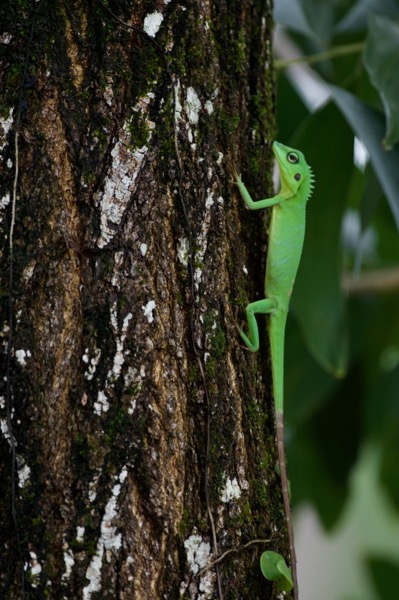
At night, the forest was full of agamids sleeping in the trees. I saw a good number of earless agamids, including this adult male that had beautiful blue eyes. Only adult males have blue eyes, but not all adult males do.
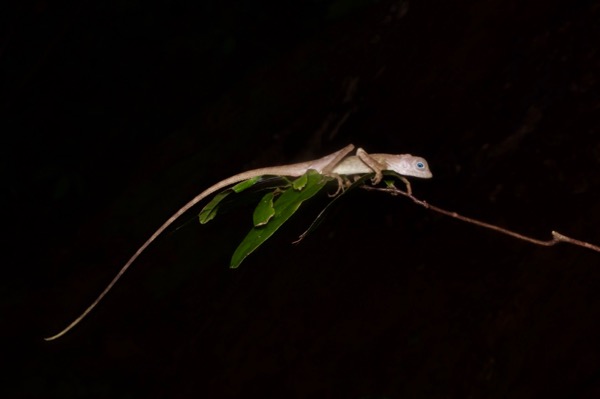
When I first spotted this next sleeping agamid, I assumed it was another Aphaniotis fusca. But its proportions didn't seem quite the same, and I later determined that it was a different species and in fact a new genus for me.
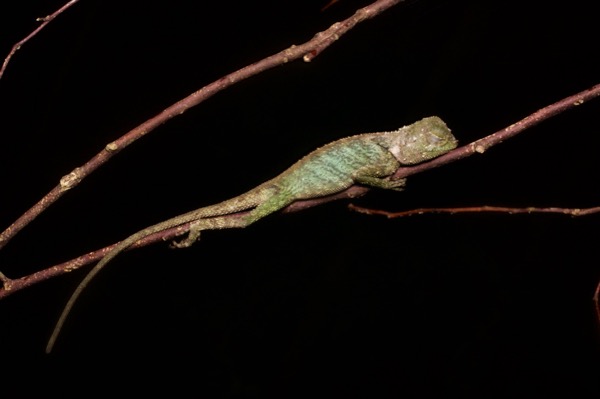
Here's a cute li'l baby sleeping agamid, peacefully defying gravity. I can't tell which of the preceding two species it belongs to. I'm leaning towards Phoxophrys, but would be happy to get any additional clues or opinions.
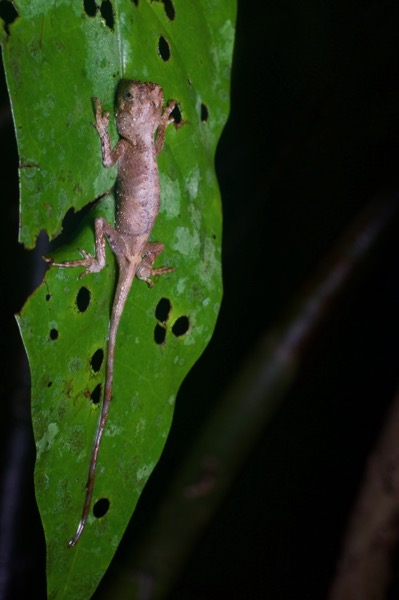
I also saw a half-dozen or so of another species that was new to me, Gonocephalus liogaster. The species is quite similar to Gonocephalus borneensis, which I had seen at Kubah. I had trouble telling the young ones apart in the field, but later learned of a clearly visible distinction: G. liogaster has a semicircle of enlarged scales between the eye and upper lip. It's not especially obvious on this youngster due to the in-progress shed, but I can still see it in the full-resolution version of this photo.
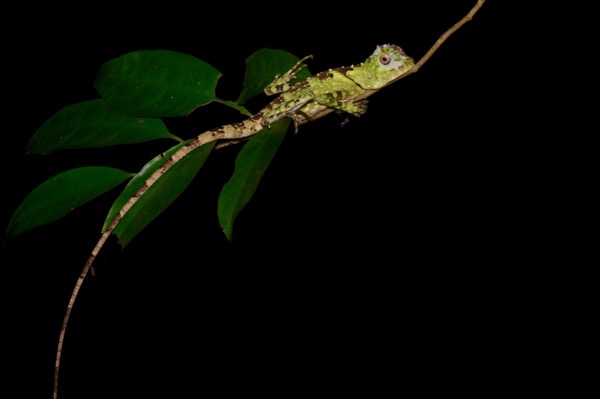
Adult males are easy to recognize due to their bright blue eyes and surrounding orange ring of scales.
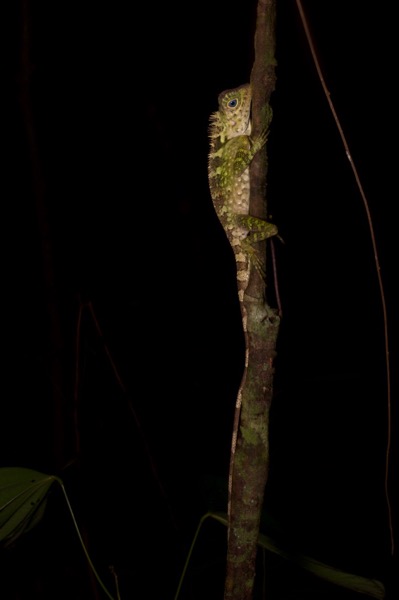
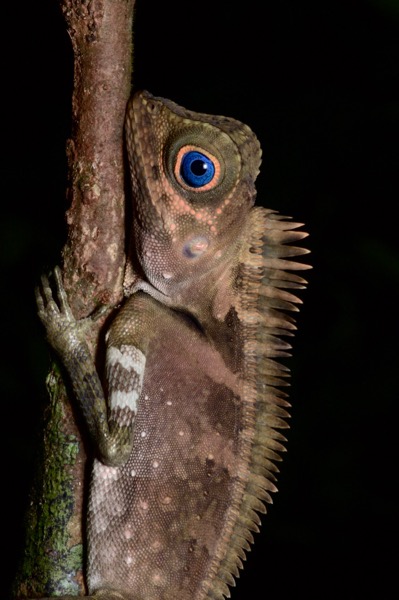
On a daytime hike at Santubong National Park I spotted a basking snake on a jumble of downed logs alongside the main creek. Sometimes it is hard for me to justify lugging my reasonably heavy 300mm lens and tripod around the rainforest, but they do enable the occasional in situ shots of wary and speedy snakes.
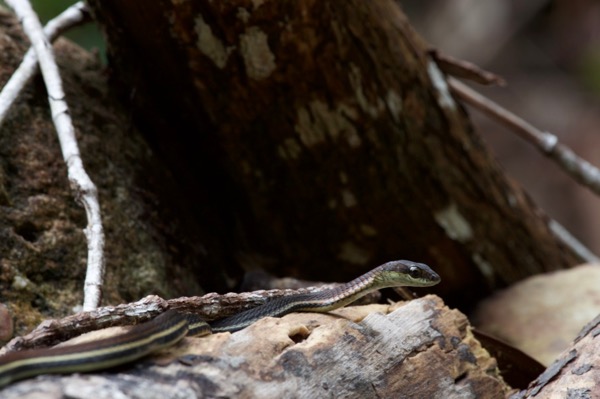
Back at Kubah I had seen my first and so far only Oriental Whip Snake when it fell in front of me while I had been photographing some tiny frogs. At Santubong I saw a few more. They are quite dramatic in appearance, mellow in disposition, and more willing to hold a pose than most arboreal colubrids. What's not to love?
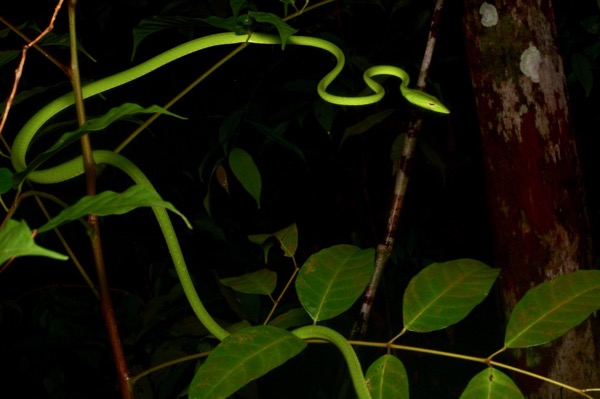
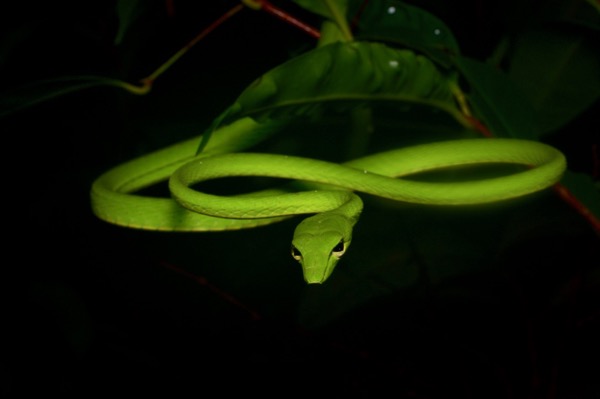
Most of these snakes were bright green, but one small individual was a surprising (to me) yellow/golden color.
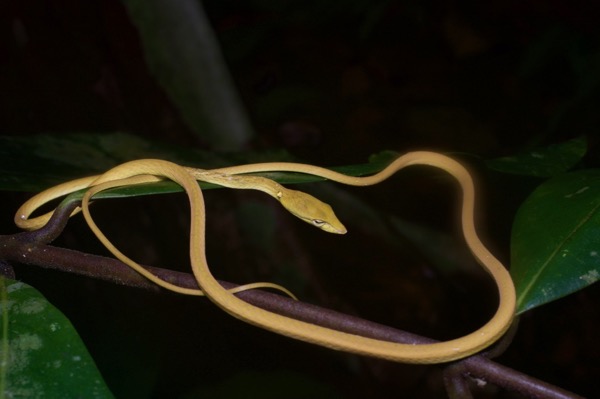
The most common (or at least most easily-seen) snake in the Santubong forest was the Bornean Keeled Pit Viper. I saw a few of these each night, mostly small ones. Here are a couple of young males.
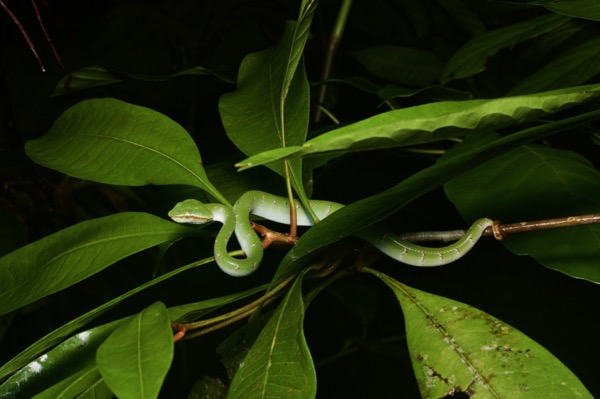
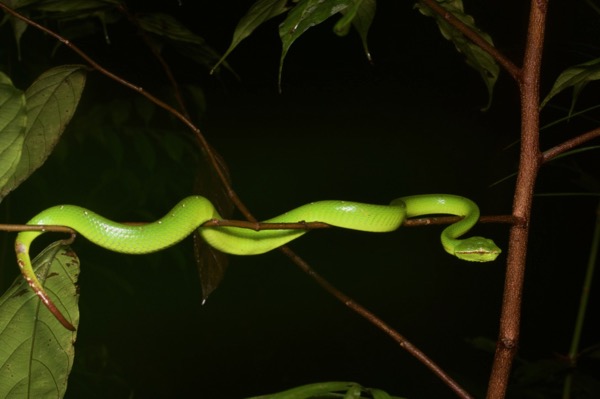
One drippy morning I was wandering the Permai beach, taking a few iPhone photos of the beautiful sand sculptures created by the local tiny crabs while I waited to see if the sun would come out so I could go look for Draco lizards.
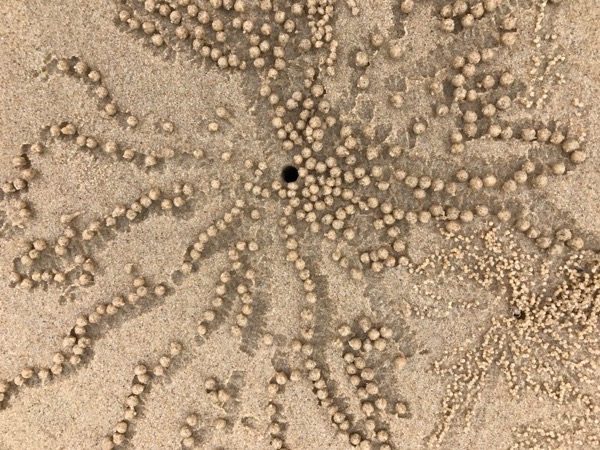
Drippy soon turned into rainy and I headed for the nearest cover, which was a couple of covered benches next to a shack where Permai rents out kayaks and such. While waiting for a break in the storm I noticed a squirrel or two climbing about in some mangroves nearby. Since I had nothing better to do, I got out my bigger camera and tripod and spent a futile ten minutes or so trying to focus on one of these active squirrels. This caught the attention of one of the rental shack attendants, who asked me in broken English whether I saw a snake. I told him that I only saw a couple of squirrels, but that I was always looking for snakes. He rephrased a bit and asked again, causing me to realize that I had misunderstood him; he was actually asking whether I wanted to see a snake. Oh, yes I did! He pointed out this gorgeous adult female T. subannulatus about two feet from the rental shack.
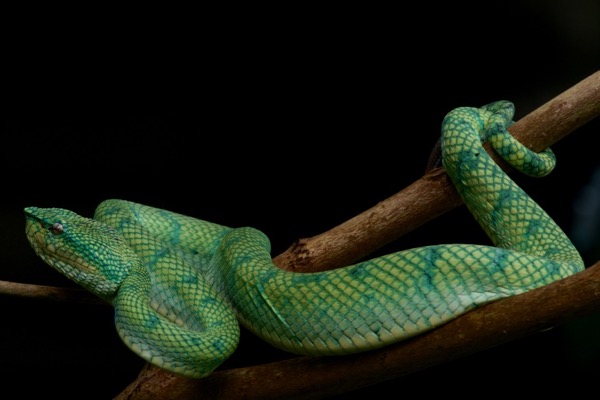
The rental shack attendant told me that the snake had been in that position for three days. She was still there that night, when I came back to visit her after a forest hike. However, she was gone the next morning.
The afternoon of the next day I saw a few people admiring something in the trees a few feet from the pathway to the Permai café. Hey look, another adult female T. subannulatus! This was thirty yards uphill from the rental shack on the beach, so I was suspicious that it might be the same snake. My suspicions were confirmed when I studied my photos later; it was definitely the same snake.
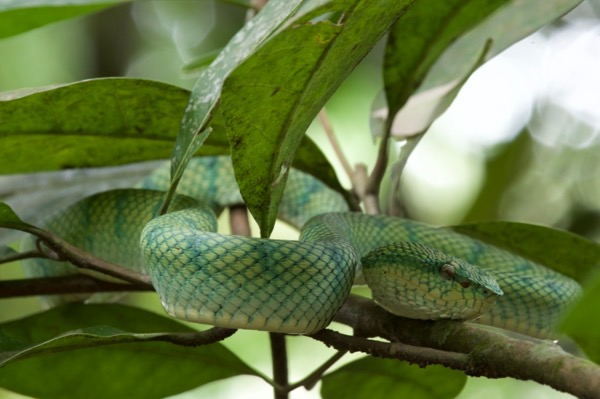
Perhaps my most exciting herpetological encounter at Santubong took place late one night and deep in the forest. I spotted something stripey in the rocks alongside a shallow stream. At first it appeared to be motionless, but then I noticed that it was very slowly moving forward, probing the space between two rocks with its head. It took me a moment to realize that it wasn't a snake, and it wasn't a weird worm. It was a caecilian, and only the second individual of that group of amphibians that I had ever seen. Fun!
I was torn between getting photos and preventing it from disappearing into the stream, but decided that I had better get at least one photo before doing anything else, so I did:
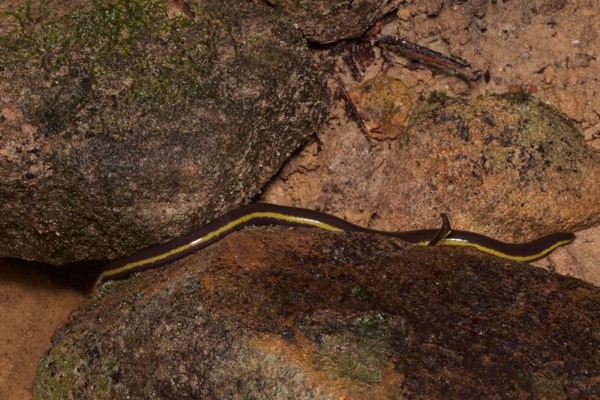
So far it hadn't seemed to notice me, but it was continuing to slip slowly forward. I decided that if I wanted a good photo I needed to at least stop this forward progress. I slowly moved my hand in front of it. When it realized my presence it freaked out and started thrashing rapidly. I had my hands on it for a moment but it was super slippery and hurtled itself into the stream. It swam in an instant to the far side and into a crevice behind a foot-long rock embedded at the stream's edge. With my flashlight held at just the right angle I could see it back there, but the crevice was too narrow to get my hand into. I tried to tickle it out with a stick, but with no luck. Then I could no longer see it with the flashlight. I dug out the rock by first removing smaller surrounding rocks, and then dug out the muddy sides of the stream with my hands, but I never caught even a glimpse of it again.
Next: Bako